The chart in the previous post that I thought was funny was Figure 1. The blue line is homes under construction the red line is homes for sale. They come from 2 different Census Bureau surveys. One covers all homes while the other just covers homes built for sale. But, these 2 measures have tracked each other in lockstep for decades (with a slight lag on homes for sale) until 2022 when they abruptly turned tail from each other.
I think it’s funny because it’s in the genre of charts where data is the opposite of what people feel comfortable asserting without looking at the data. Here, there are 2 sources of data that are telling the opposite story in real time.
Understanding why they suddenly turned tail is a key part of understanding the current housing market. Is new home inventory up 20% or down 20% over the last 3 years? That’s a big difference. The explanation is below the paywall on that post. Substack does offer 7 day free trials for new subscribers. I like to think there are plenty of ways that seeing the analysis I put in the subscriber-only posts will help you make better economic decisions and pay for itself.
More funny charts below.
Low Interest Rates and Malinvestment
This is an old one I like. Did the Fed cause a housing bubble with low interest rates? This one is the federal funds rate and home prices in Phoenix from 2002-2012. Reflecting conventional wisdom, John Taylor and Ed Leamer told Fed members at their Jackson Hole symposium in August 2007 that their low interest rates had caused a housing bubble.
Isn’t this funny?
“Long and variable lags” in market reactions to interest rates are the usual way to try to make this make sense, though I don’t recall Taylor or Leamer telling the FOMC to speed up their rate cuts because it might take a couple years for markets to react to them.
These funny charts aren’t caused by accident. If someone was just wrong, you’d expect a bunch of randomly moving measures. You’d expect, maybe, a weak correlation or a lack of correlation. They have such a funny contrary pattern because the causation is backwards in a specific way. In broad terms, problems caused by supply are being blamed on demand. So the data frequently gives you the exact opposite picture of the assertion.
The reason the chart is the exact opposite of what you’d expect rather than just uncorrelated is that it is an outcome of the incorrect conventional wisdom. This chart is what it would look like for the Fed to mistakenly attribute high home prices to excessive demand or low interest rates. They would raise rates to try to bring home prices down and end up going too far. The chart looks like this because rising and falling home prices caused rising and falling Fed rates, with a slight lag.
ZIRP and Rental Housing Investors
The next funny chart is the mirror image of the Phoenix chart, after 2008.
After 2008, the conventional albatross was ZIRP (zero interest rate policy). Of course, ZIR is not a P. There was no other functional interest rate target the Fed could have chosen. The crash in September 2008 was triggered when they really, really tried to keep the target rate at 2% when the neutral rate was already at zero.
You can assert without empirical debate that ZIRP created an investment boom in housing. Figure 3 shows the Fed’s interest rate target and the Case-Shiller index for Atlanta, here showing the price trend for low tier homes relative to high tier homes. I don’t think the idea that investors started buying into low tier Atlanta because of ZIRP is wrong. I think it’s funny.
It’s like if conventional wisdom was dead set on the claim that the 1980s Lakers secret to success was Kurt Rambis. How would you even approach people about that if people could make that assertion without even looking at the statistics because everyone would agree with the claim? I loved Kurt Rambis. His gritty play probably helped them win a few extra games.
“Look, I agree that Magic Johnson and Kareem Abdul-Jabbar made important contributions, but...” would not be a signal of fruitful debate ahead. It would be funny. It would be satire.
Did ZIRP cause low tier prices in Atlanta to lose more than half their value? Again, the reason reality is upside-down from the convention is because the causation is specifically reversed. If anything, IR was driven further toward Z because we suddenly legally blocked about $300 billion of borrowing demand through federal underwriting regulations.
If you have a complicated theory about why investors in 2012 decided to start buying dimes for a nickel, then “I'm really happy for you, I'mma let you finish, but” there may not be a mystery there waiting for your theory to solve it.
All the good jobs are in just a few cities
Another chart I think is funny is when people say that our problem isn’t that we have a shortage of homes, it’s that there are only a few cities with great job opportunities, and that is why they are expensive. And then you look up a chart of job growth or population growth in the cities they are talking about.
Cyclical home price inflation is now systematically associated with the speed at which the “superstar” cities depopulate. The faster they shrink, the more expensive homes get elsewhere.
As Joey Politano replies to people making these claims, “If you think we need to ‘move economic opportunity away from a few metro areas’ congratulations you won! We did it! In fact we've been doing it for years!”
Hot Water
The problem here is that there has to be a large body of shared knowledge that is accepted as fact. Our community of knowledge is Bayesian. We are all constantly updating our priors based on new information. We adjust the probability that x is true when we see y happen. But, in reality, there has to be a large number of issues that we treat as if they have a prior probability of 100%.
Ideologues apply that certainty to too many things. But we all have to apply it to a lot of things. We would be suffocated if we didn’t. We don’t leave magic shows and go spend a week at the library confirming our understanding of gravity. We assume we’re seeing a trick.
You could roughly describe our set of shared certainties as “conventional wisdom”. And, I think that’s what’s happening when people assert that the big, expensive cities just can’t keep up with the demand for concentrated economic growth, or that investors started buying homes because of ZIRP, or that home prices were high in Phoenix in 2006 because of low interest rates, or that homebuilders are drowning in speculative inventory because they always overbuild until there is a correction, or that Las Vegas had tens of thousands of extra vacant homes from 2008 to 2013 because of an irrational building boom.
That last one makes for another funny chart.
Anyway, the problem is that conventional wisdom says, “You don’t need to look up the number of new home permits that were issued in Nevada. We know this with certainty. There was a building boom.”
And, so it leads to a difficult dynamic. You can’t update from certainty. In physical nature, the hotter a pot of water is, the faster it will cool. But, for humans, the more wrong we are, the harder it is for us to learn.
And the reason is that the only way you get to a narrative that adds up to “Nevada had nearly 100,000 vacant homes in 2010 because low interest rates had caused a frenzy of overzealous building.” is by having an entire web of supporting claims that conventional wisdom said you could believe without checking on them.
So, all these funny charts, in isolation, seem like “gottchas” - like a magic show - to those who have asserted the opposite claim. They must be some sort of anomaly that clearly defies your expectations, but that isn’t worth a week in the library to study up on gravity.
ZIRP and Homeownership
Another funny chart that I recently happened upon was a Fred chart that I looked up after I saw someone claim that “ZIRP and QE made real interest rates SO low that it caused a decent number of people to switch from rent to buy.”
I mean, come on. That’s funny. Instead, homeownership flatlined for a decade, during, “ZIRP”, and then suddenly gasped back to life as interest rates increased.
I’m sure the person that made this claim didn’t find this chart compelling, precisely because it’s so perfectly aligned in the wrong way. They aren’t going to spend a week studying gravity over this. They only made that assertion without ever having checked any data because there is a whole web of unreliable assertions all working together toward a very specific form of wrongness. They are living in a funhouse mirror room of certainties. There are 8 other facts that they know without checking that confirm for them that this is just a trick.
The reason it is so precisely aligned, and not just messy, is because the assertion is built on a specific mental model that has all the causality wrong. It’s demand focused instead of supply focused, so it won’t just be unuseful. It is a reliable countersignal.
Interest rates probably started to rise again, in part, because we were finally naturally regrowing out of the mortgage crackdown and there was finally some increasing demand for debt from new homebuyers, increasing construction employment, more real economic growth, etc.
Household Trends
The last claim led me to revisit trends in housing and households from the Census Bureau’s Housing Vacancies and Homeownership report.
Don’t be too serious about these. I have added a linear trendline, but these aren’t naturally linearly growing measures. They naturally should grow exponentially, but they are growing exponentially at a slower rate. Some of that is demographics. Some is immigration and fertility trends. Though, the growth of adult population hasn’t varied that much over the last 60 years.
Anyway, it’s sort of surprising how well a linear trendline fits the 3 categories of housing before we broke it. And, it should be surprising to see that none of the categories of housing ever breaks higher than that long-term trend line except for vacancies. And when vacancies did break a couple million units above trend, it was after several years of the housing bust had pushed total construction a couple million units below trend.
There are several “back of the envelope” level points that jump out of these chart. One is they provide a short-hand for my “20 million units” shortage meme, and it’s evenly distributed. Each category - vacant, rented, and owned - is about 7 million units short of the linear trend.
Now, renter households were already that far short of trend in 2008 when the mortgage crackdown created a shortage, so maybe the shortage is 15 million - roughly half is vacancies and half is renter households that will form as rental homes are constructed while the number of homeowners moves along parallel to the linear trend, but permanently 7 million households short.
What caused the downtrend in renters from 1994 to 2004? Part of it was innovations in mortgage access for qualified but previously underserved borrowers. Part of it, I think, maybe, was a demographic lull in population growth of adults at prime homebuying ages, between the boomers and the boomers’ children. Part of it was the mass migration out of the stagnant coastal urban centers, which have low homeownership rates, out to other cities where homeownership was more attainable. And, I wonder how much that caused a transition from renter to owner and how much it reduced household formation in the Closed Access cities.
If New York, Los Angeles, Boston, and San Francisco could grow at, say, the national average, would that have mostly pulled the number of renter households higher or would it have increased the number of renters but also decreased the number of owners? There are several moving parts there. It’s hard to know. I think it’s safe to assume that there was some drag on total household formation. Also, if the Closed Access cities were normal, there would probably be about a million additional vacant homes.
I think there was some complicated downward pressure on household formation between 1994 and 2004. It maybe doesn’t explain the entire downward deviation in renter households. But, more simply, the rise in the homeownership rate from 1994 to 2004 wasn’t associated with a bulging trend in the housing stock. The rise in homeownership rate was entirely due to a declining number of rental households while owner households hued closely to the 4-decade old linear trend.
Exactly how did this end up stretching our productive capacity and leaving us with supposedly millions of homes we had no use for?
Finally, on renters, looking at the data this way really highlights the effects of the subprime boom. On net, it was funding investors, not homeowners. The trend up in renter households really hits in 2004. I have been writing about how there was a need for investors after the 2008 mortgage crackdown, but the trend in renter households didn’t really change after 2008. The trend from 2004 just continued.
The 2004-2007 period was dominated by small-scale investors - the chumps we throw popcorn at when we watch “The Big Short”. I suppose the point this conveys is that the need for new investors from 2009 to 2016 that pulled in large-scale investors was as much about replacing the previous failed investors as it was about funding a new, exceptionally high number of rental units.
From 2004 to 2010, rental households increased at about the normal historical linear rate. Then, from 2010 to 2016, the number of new renter homes accumulated at about double the historical norm - adding up to about 6 million additional renter households instead of 3 million, compared to 2010. But, since then, those 3 million extra households have dissipated. If you move the linear trendline down to the new lower level in 2008, renter households are back down to the trendline in 2024.
As I have documented in other posts, there has sort of been a recent recovery in the homeownership rate, since 2016, but that is mostly due to a lack of growth among renter households while growth of owner households is mostly just tracking the long-term normal growth trend, but at a new level 7 million units lower.
Moving forward, new homes for homeowners will continue along near the rate it has been. New apartments, where legal, will house new renter households, and when they aren’t legal, new single-family rentals will help bridge the gap between renter household demand and rental household formation. Until they are illegal.
While all that happens, until it is illegal, the number of vacant units will also start to trend back to normal. And, also, the relative number of vacant homes will be a signal to suggest the scale of how large the gap between the rental homes we need and the rental homes we have is.
Quarterly data suggests normalization is starting to happen. By the way, this is one thing to keep in mind if you are worried about the rising quantity of existing homes for sale. From 1995 to 2005, the rate of owned homes that were vacant and for sale ranged between 1.5% and 1.8%. In the first quarter of 2025, it had recovered back from a low of 0.7% to 1.1%. The years 1995 to 2005 were not associated with meaningful declines in demand for new homes and the year 2025 will not be either. We’re not even in the ballpark.
Where there is currently some regional softness, it is not a signal of a national cyclical turn.


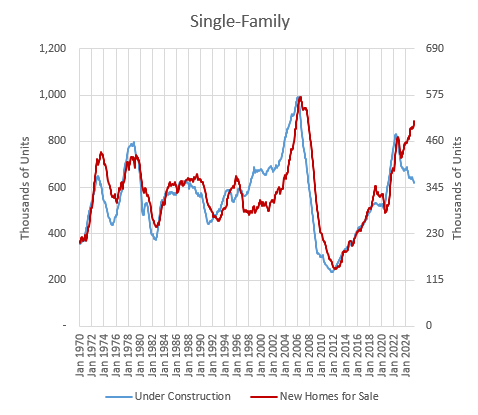
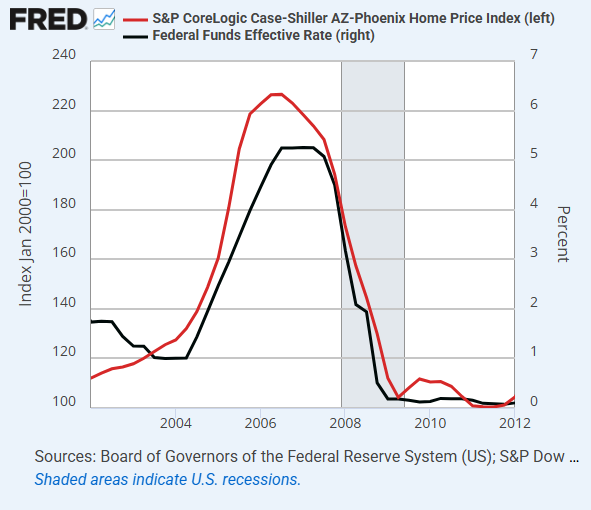
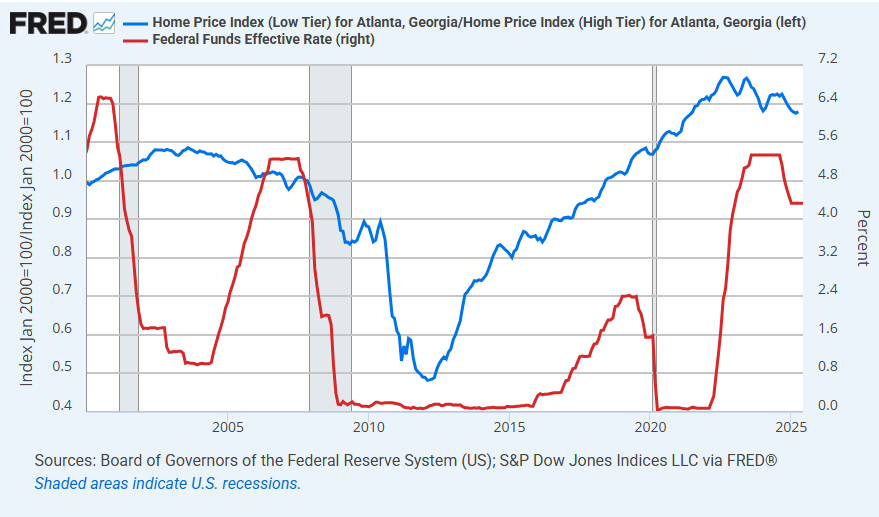
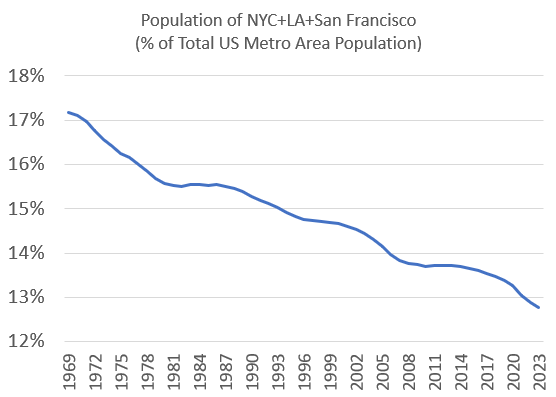
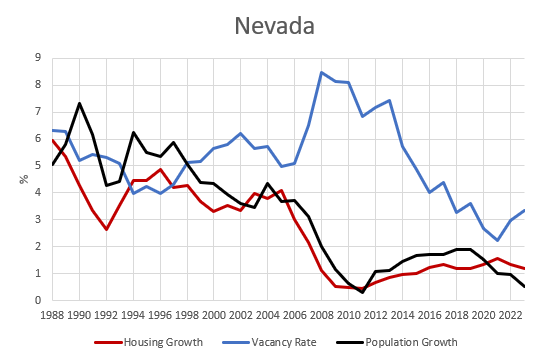
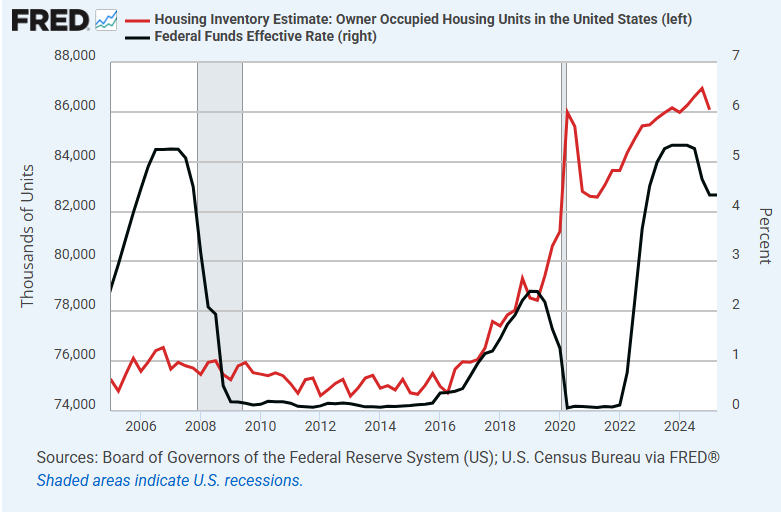

To your point about the superstar cities driving people away despite income premiums, there’s a genuine difference between these scenarios:
1. Person feels priced out of Manhattan, moves to Phoenix for better affordability despite a relative pay cut.
2. Person feels priced out of Manhattan, moves to Buffalo to stay in region, helps drive slowly increasing unaffordability in Buffalo.
3. Person feels priced out of Manhattan and doesn’t want to live more than 3 hours away, moves out past Easton, PA (IE deepest western outskirts of NYC). Houses are dirt cheap because it’s bumblefuck Pennsylvania.
4. Person feels priced out of Manhattan, moves to deep LI or CT suburbs outside of census tract but well within 3 hours; houses are barely affordable with a stretch on two incomes, but vastly more spacious than the city.
5. Person feels priced out of Manhattan, moves to nearby suburbs mostly within greater NYC census tract. Is paying only one arm/leg for twice the space as Manhattan, but it’s still brutal and preventing saving for homeownership.
6. Person feels priced out of Manhattan, stays in Manhattan.
For the record, I’m roughly a 5.
But as we look at income relative to the superstar city… in 3-6, it’s entirely possible to hold the same job and income from Manhattan, while only 5-6 get counted as “living in the superstar city”! And although pre-2020, 1 was a BIG stretch to hold down a Manhattan job, 1-2 are not nearly as much of a stretch anymore in the post-2020 remote work era (and yes, I already know that trend was overblown, I’m only factoring in the properly-blown part here).
Moreover, that’s JUST for Manhattan jobs! There’s still more difference between someone moving from Manhattan to a farm out past Easton PA for cheaper housing, and someone who grew up down the road from that farm, runs his granddad’s mechanic shop, and is struggling against all the rich city folk bidding up housing in the area.
All of that is to say, I’m not sure we’re getting the full picture on flight from the superstar cities. I would like to know what the mix of flight was in terms of (1) distance of flight from the city, (2) relative cost-to-income differential incurred, and (3) absolute cost and income differentials.
Because it almost certainly IS a “mix”of 1-6, even more categories. But I’d like to know whether it’s (in descending order) “60/30/3/2/2/2/1”, “5/20/25/25/20/2”, “1/2/2/2/3/30/60”, or whatever else.
Just speculating, if it’s heavily loaded towards Phoenix, then we know “available-room-to-sprawl” was probably dominant, mortgage access not so much, and income wasn’t decisive for most fleers. If it’s a relatively even mix among 1-6, then all factors are most likely. And if most people were just fleeing to within long commute distance, then we credit lack of mortgage access for forcing people to buy up existing sprawl to maintain their incomes.
Looking at figure 6, I wonder how much that is just the millennial “echo boom” hitting adulthood/homebuying age in an unusually concentrated wave. Unusually concentrated, because it’s a population wave in the first place, but in the second place, because people at the leading edge of that wave entered adulthood directly into the recession and spent 3 to 6 years with way below normal earnings (speaking from personal experience), and it took longer to catch up.
Living through that time period, it felt like everyone who was 30 to 40 years old all reached adult buying power at the exact same time, because we’d all finally had a “good job” for about the same length of time… and notably later in life than the boomers reached that point.
That’s just one piece of this whole story but I find it interesting.